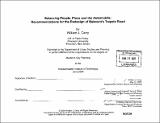Balancing people, place and the automobile : recommendations for the redesign of Belmont's Trapelo Road
Author(s)
Carry, William J
DownloadFull printable version (10.05Mb)
Other Contributors
Massachusetts Institute of Technology. Dept. of Urban Studies and Planning.
Advisor
Terry S. Szold.
Terms of use
Metadata
Show full item recordAbstract
This thesis presents a case study of the planning process for the redesign of Trapelo Road in Belmont, Massachusetts, a Boston suburb. The case is an on-going planning controversy that deals with a number of key issues facing inner-ring suburbs: the impact of sprawl development on older commercial areas, the difficulties inherent in encouraging alternate modes of transportation in the suburban context, and the challenge of addressing regional forces on the local level. Within the Belmont community, there is considerable conflict over the redesign of the Trapelo corridor. On one side are advocates of narrowing the road to two lanes who see Trapelo as an opportunity to create a neighborhood "Main Street" with an enhanced sense of place. On the other side are advocates of maintaining the road in its current four- lane configuration who see the corridor as an important artery for local and regional traffic and are most concerned with traffic congestion. The thesis endeavors to learn from and inform the Trapelo Road planning debate and to answer the following research question: on suburban roads such as Trapelo, to what extent does there exist a trade-off between improving the pedestrian environment and neighborhood character, and preserving road capacity and traffic flow? In other words, is the redesign of Trapelo Road a zero-sum game? The promise of smart growth and new urbanism is that more balanced approaches to street design and transportation planning can benefit everyone, including drivers, pedestrians, bicyclists, and local business owners. The thesis examines the Trapelo corridor through three lenses: the regional context, the neighborhood context, and at the intersection level. (cont.) The analysis indicates that Trapelo redesign does entail real trade-offs between congestion reduction, and pedestrian safety and neighborhood character. However, narrowing the road would impose fewer costs than turning Trapelo into a major suburban arterial.
Description
Thesis (M.C.P.)--Massachusetts Institute of Technology, Dept. of Urban Studies and Planning, 2005. Includes bibliographical references (p. 71-73).
Date issued
2005Department
Massachusetts Institute of Technology. Department of Urban Studies and PlanningPublisher
Massachusetts Institute of Technology
Keywords
Urban Studies and Planning.